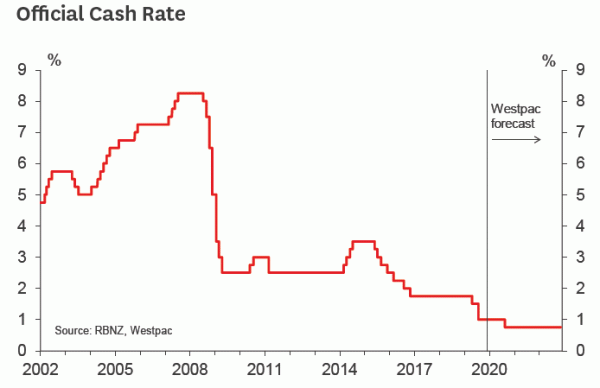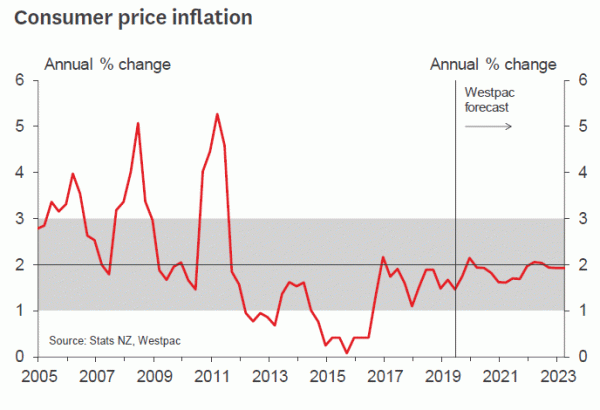- We no longer expect the RBNZ will cut the OCR in February, or at any point over the first half of 2020.
- The New Zealand economy and housing market have lived up to our more constructive forecasts and then some.
- Meanwhile, global economic sentiment has held up recently.
- Although we expect the global economy to deteriorate next year, the NZ housing market and economic upturn will prevent the RBNZ from cutting over the first half of 2020.
- We are now forecasting that the OCR will drop to 0.75% in August.
- Our OCR forecast strikes a balance within a spectrum of possibilities. We could easily envisage the OCR remaining at 1% all year or falling to 0.5%, depending on the data.
- A cut of some kind remains more likely than on hold or hikes, because of lingering softness in the inflation outlook.
- We will continue to update our OCR forecasts as and when required by new information
We no longer expect the RBNZ to cut the OCR in February, or at any point in the first half of 2020.
At the time of the November Monetary Policy Statement the Reserve Bank implied that there was roughly a 50/50 chance that it would reduce the OCR at some point, to be determined by the data.
We expected that New Zealand economic data, particularly the housing market, would exceed the Reserve Bank’s expectations. Even so, we pencilled in a February OCR cut on the basis that a renewed bout of global economic jitters could push the RBNZ over the very fine line on which it has been dancing.
Our forecast for a modest improvement in the New Zealand economy has proved correct and then some, and so far there hasn’t been a marked deterioration in global economic sentiment. This means a February OCR cut is now looking unlikely.
The New Zealand housing market has taken off even more sharply than our bullish forecasts. Back in May our prediction of 7% house price inflation next year made us the only major house tipping a housing market upturn. Now house price inflation is already 5.6% according to the REINZ House Price Index, and all and sundry are talking about how the market has turned.
In response to rising house prices, households have opened their wallets. Retail sales volumes rose by 1.6% in the September quarter. The momentum has continued since then, albeit with some volatility – a 0.5% drop in electronic card spending in October was followed by a whopping 2.6% rise in November.
Indicators of business activity have improved as well. Business confidence is still low but has risen in the last couple of surveys. The PMI manufacturing survey suggests that the sector is back in growth mode. And residential building consents have been going from strength to strength and are up by 12% on the previous year.
The Government’s recent announcement of a large increase in planned infrastructure spending doesn’t significantly alter our forecasts, as we already recognised that a pre-election spendup was likely. But it will come as a positive surprise relative to the forecasts that the Reserve Bank published in November.
The only real counter to the string of upside surprises for the RBNZ is that the New Zealand dollar has risen recently. The trade-weighted index is 2% above where the RBNZ expected it to be at this point. This will dampen the RBNZ’s near-term inflation forecasts, but it only goes some way towards offsetting the 6% rise in export commodity prices seen since July.
Global economic sentiment has held up well recently, but we still anticipating a deterioration next year because we expect the US economy to slow. We are forecasting that the Federal Reserve and Reserve Bank of Australia will be reducing interest rates next year. However, the current New Zealand housing market and economic upturn will have momentum. By May, we expect the New Zealand housing market will be even stronger than today, while annual inflation will touch 2.1% (although it will drop again soon after). Under those conditions, we doubt the RBNZ would cut the OCR by May even if global economic conditions have deteriorated.
The OCR outlook over the second half of 2020 is murkier. We are now forecasting that the OCR will fall to 0.75% in August, and will stay at that level for two and a half years.
Our forecast strikes the best balance within a spectrum of possibilities in a highly uncertain future. We could easily imagine a scenario in which the OCR is kept on hold at 1.00% throughout 2020, for example if the New Zealand housing market turns out even stronger than we currently anticipate. Alternatively, the OCR could fall to 0.50% or below this year, particularly if the global economy falters to a greater extent than we are forecasting.
A lower OCR in some shape or form does remain the most likely outcome. That is because the inflation outlook remains slightly below 2%. Our forecasts of a weak world economy and a rising exchange rate trump the accelerating domestic economy in terms of the inflation outlook. And under conditions of a sub-2% inflation outlook, it makes sense to forecast a lower OCR.
We will continue to update our OCR forecasts as and when required by new information.
Update to our wider forecasts.
We will also take this opportunity to update our wider economic forecasts. The details are in the table on the following page, and the highlights are:
Previously, we forecast that house price inflation would reach 7% by the end of 2020. We now expect 7% will be reached by April next year, as the market is accelerating faster than expected. However, with mortgage rates now rising and expected to rise further next year, we also expect the housing market upturn will start petering out as soon as late-2020.
We have updated our forecasts of government spending to reflect the investment boost announced in last week’s half year update. But at the same time, we have downgraded our forecast of government operational spending, because it looks as though surpluses will not be sufficient to support the spending increase we expected. Overall, we are now forecasting a slightly smaller fiscal stimulus than we were previously forecasting.
We have upgraded our exchange rate forecasts to reflect the fact that we now expect the central banks of Australia and the US will be reducing rates while the RBNZ is on hold in the first half of 2020. For June 2020, we are now forecasting NZD/USD at 0.64 (previously 0.62) and NZD/ AUD at 0.97 (previously 0.94).














